steering FORD SIERRA 1992 2.G SOHC Engines Workshop Manual
[x] Cancel search | Manufacturer: FORD, Model Year: 1992, Model line: SIERRA, Model: FORD SIERRA 1992 2.GPages: 24, PDF Size: 1.03 MB
Page 8 of 24
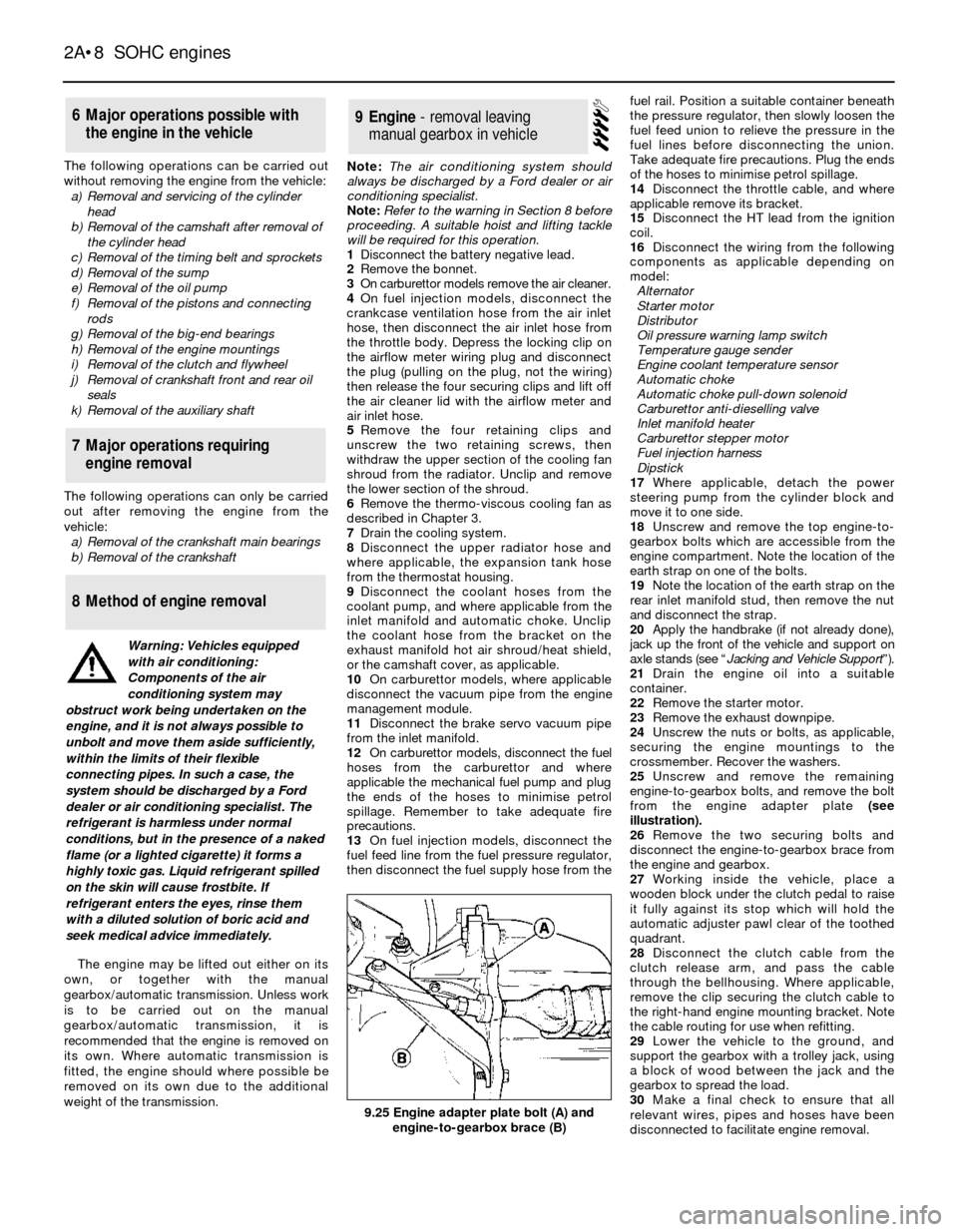
The following operations can be carried out
without removing the engine from the vehicle:
a)Removal and servicing of the cylinder
head
b)Removal of the camshaft after removal of
the cylinder head
c)Removal of the timing belt and sprockets
d)Removal of the sump
e)Removal of the oil pump
f)Removal of the pistons and connecting
rods
g)Removal of the big-end bearings
h)Removal of the engine mountings
i)Removal of the clutch and flywheel
j)Removal of crankshaft front and rear oil
seals
k)Removal of the auxiliary shaft
The following operations can only be carried
out after removing the engine from the
vehicle:
a)Removal of the crankshaft main bearings
b)Removal of the crankshaft
The engine may be lifted out either on its
own, or together with the manual
gearbox/automatic transmission. Unless work
is to be carried out on the manual
gearbox/automatic transmission, it is
recommended that the engine is removed on
its own. Where automatic transmission is
fitted, the engine should where possible be
removed on its own due to the additional
weight of the transmission. Note: The air conditioning system should
always be discharged by a Ford dealer or air
conditioning specialist.
Note: Refer to the warning in Section 8 before
proceeding. A suitable hoist and lifting tackle
will be required for this operation.
1Disconnect the battery negative lead.
2Remove the bonnet.
3On carburettor models remove the air cleaner.
4On fuel injection models, disconnect the
crankcase ventilation hose from the air inlet
hose, then disconnect the air inlet hose from
the throttle body. Depress the locking clip on
the airflow meter wiring plug and disconnect
the plug (pulling on the plug, not the wiring)
then release the four securing clips and lift off
the air cleaner lid with the airflow meter and
air inlet hose.
5Remove the four retaining clips and
unscrew the two retaining screws, then
withdraw the upper section of the cooling fan
shroud from the radiator. Unclip and remove
the lower section of the shroud.
6Remove the thermo-viscous cooling fan as
described in Chapter 3.
7Drain the cooling system.
8Disconnect the upper radiator hose and
where applicable, the expansion tank hose
from the thermostat housing.
9Disconnect the coolant hoses from the
coolant pump, and where applicable from the
inlet manifold and automatic choke. Unclip
the coolant hose from the bracket on the
exhaust manifold hot air shroud/heat shield,
or the camshaft cover, as applicable.
10On carburettor models, where applicable
disconnect the vacuum pipe from the engine
management module.
11Disconnect the brake servo vacuum pipe
from the inlet manifold.
12On carburettor models, disconnect the fuel
hoses from the carburettor and where
applicable the mechanical fuel pump and plug
the ends of the hoses to minimise petrol
spillage. Remember to take adequate fire
precautions.
13On fuel injection models, disconnect the
fuel feed line from the fuel pressure regulator,
then disconnect the fuel supply hose from thefuel rail. Position a suitable container beneath
the pressure regulator, then slowly loosen the
fuel feed union to relieve the pressure in the
fuel lines before disconnecting the union.
Take adequate fire precautions. Plug the ends
of the hoses to minimise petrol spillage.
14Disconnect the throttle cable, and where
applicable remove its bracket.
15Disconnect the HT lead from the ignition
coil.
16Disconnect the wiring from the following
components as applicable depending on
model:
Alternator
Starter motor
Distributor
Oil pressure warning lamp switch
Temperature gauge sender
Engine coolant temperature sensor
Automatic choke
Automatic choke pull-down solenoid
Carburettor anti-dieselling valve
Inlet manifold heater
Carburettor stepper motor
Fuel injection harness
Dipstick
17Where applicable, detach the power
steering pump from the cylinder block and
move it to one side.
18Unscrew and remove the top engine-to-
gearbox bolts which are accessible from the
engine compartment. Note the location of the
earth strap on one of the bolts.
19Note the location of the earth strap on the
rear inlet manifold stud, then remove the nut
and disconnect the strap.
20Apply the handbrake (if not already done),
jack up the front of the vehicle and support on
axle stands (see ÒJacking and Vehicle SupportÓ).
21Drain the engine oil into a suitable
container.
22Remove the starter motor.
23Remove the exhaust downpipe.
24Unscrew the nuts or bolts, as applicable,
securing the engine mountings to the
crossmember. Recover the washers.
25Unscrew and remove the remaining
engine-to-gearbox bolts, and remove the bolt
from the engine adapter plate (see
illustration).
26Remove the two securing bolts and
disconnect the engine-to-gearbox brace from
the engine and gearbox.
27Working inside the vehicle, place a
wooden block under the clutch pedal to raise
it fully against its stop which will hold the
automatic adjuster pawl clear of the toothed
quadrant.
28Disconnect the clutch cable from the
clutch release arm, and pass the cable
through the bellhousing. Where applicable,
remove the clip securing the clutch cable to
the right-hand engine mounting bracket. Note
the cable routing for use when refitting.
29Lower the vehicle to the ground, and
support the gearbox with a trolley jack, using
a block of wood between the jack and the
gearbox to spread the load.
30Make a final check to ensure that all
relevant wires, pipes and hoses have been
disconnected to facilitate engine removal.
9Engine - removal leaving
manual gearbox in vehicle
8Method of engine removal
7Major operations requiring
engine removal
6Major operations possible with
the engine in the vehicle
2A¥8SOHC engines
9.25 Engine adapter plate bolt (A) and
engine-to-gearbox brace (B)
Warning: Vehicles equipped
with air conditioning:
Components of the air
conditioning system may
obstruct work being undertaken on the
engine, and it is not always possible to
unbolt and move them aside sufficiently,
within the limits of their flexible
connecting pipes. In such a case, the
system should be discharged by a Ford
dealer or air conditioning specialist. The
refrigerant is harmless under normal
conditions, but in the presence of a naked
flame (or a lighted cigarette) it forms a
highly toxic gas. Liquid refrigerant spilled
on the skin will cause frostbite. If
refrigerant enters the eyes, rinse them
with a diluted solution of boric acid and
seek medical advice immediately.
Page 10 of 24
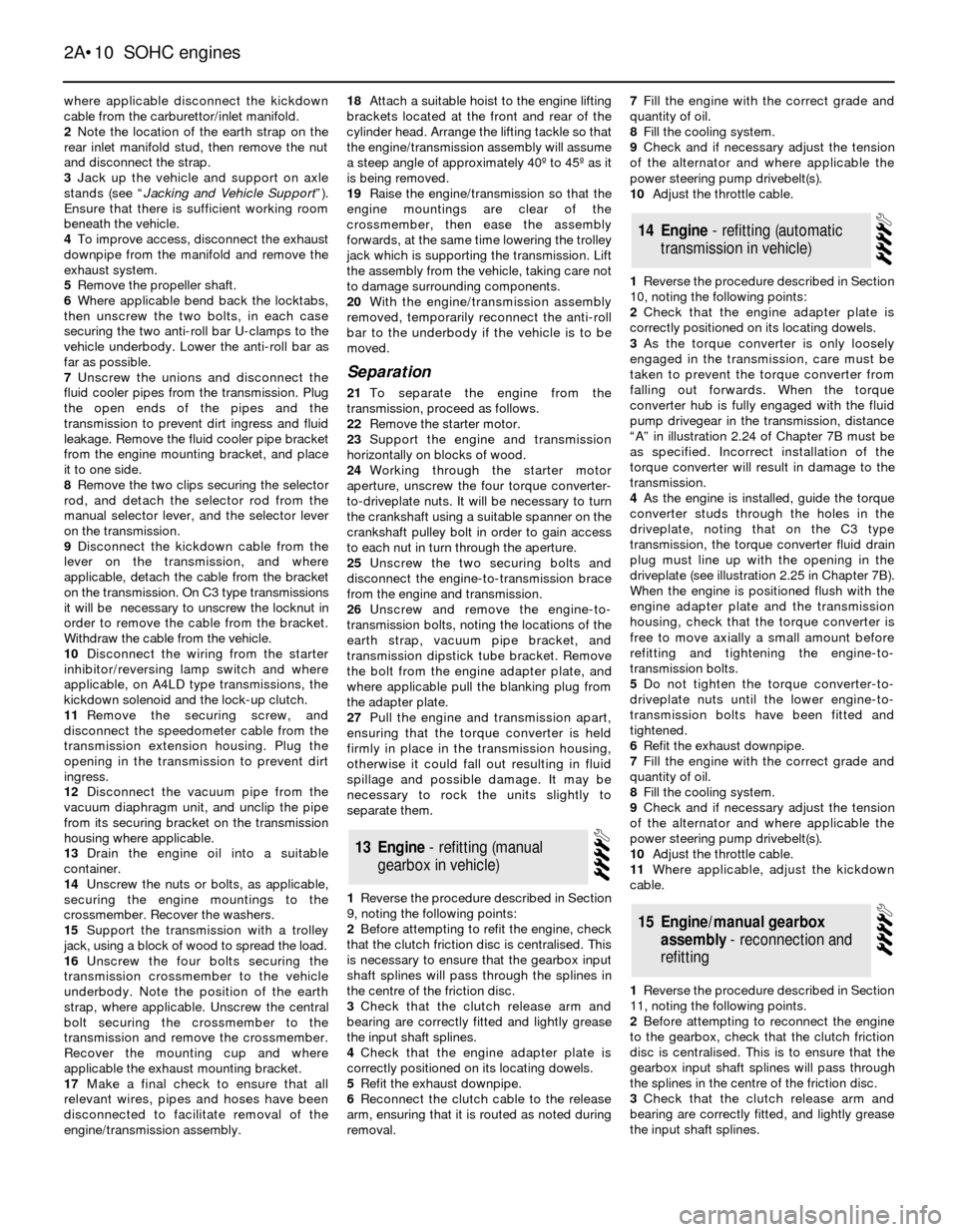
where applicable disconnect the kickdown
cable from the carburettor/inlet manifold.
2Note the location of the earth strap on the
rear inlet manifold stud, then remove the nut
and disconnect the strap.
3Jack up the vehicle and support on axle
stands (see ÒJacking and Vehicle SupportÓ).
Ensure that there is sufficient working room
beneath the vehicle.
4To improve access, disconnect the exhaust
downpipe from the manifold and remove the
exhaust system.
5Remove the propeller shaft.
6Where applicable bend back the locktabs,
then unscrew the two bolts, in each case
securing the two anti-roll bar U-clamps to the
vehicle underbody. Lower the anti-roll bar as
far as possible.
7Unscrew the unions and disconnect the
fluid cooler pipes from the transmission. Plug
the open ends of the pipes and the
transmission to prevent dirt ingress and fluid
leakage. Remove the fluid cooler pipe bracket
from the engine mounting bracket, and place
it to one side.
8Remove the two clips securing the selector
rod, and detach the selector rod from the
manual selector lever, and the selector lever
on the transmission.
9Disconnect the kickdown cable from the
lever on the transmission, and where
applicable, detach the cable from the bracket
on the transmission. On C3 type transmissions
it will be necessary to unscrew the locknut in
order to remove the cable from the bracket.
Withdraw the cable from the vehicle.
10Disconnect the wiring from the starter
inhibitor/reversing lamp switch and where
applicable, on A4LD type transmissions, the
kickdown solenoid and the lock-up clutch.
11Remove the securing screw, and
disconnect the speedometer cable from the
transmission extension housing. Plug the
opening in the transmission to prevent dirt
ingress.
12Disconnect the vacuum pipe from the
vacuum diaphragm unit, and unclip the pipe
from its securing bracket on the transmission
housing where applicable.
13Drain the engine oil into a suitable
container.
14Unscrew the nuts or bolts, as applicable,
securing the engine mountings to the
crossmember. Recover the washers.
15Support the transmission with a trolley
jack, using a block of wood to spread the load.
16Unscrew the four bolts securing the
transmission crossmember to the vehicle
underbody. Note the position of the earth
strap, where applicable. Unscrew the central
bolt securing the crossmember to the
transmission and remove the crossmember.
Recover the mounting cup and where
applicable the exhaust mounting bracket.
17Make a final check to ensure that all
relevant wires, pipes and hoses have been
disconnected to facilitate removal of the
engine/transmission assembly.18Attach a suitable hoist to the engine lifting
brackets located at the front and rear of the
cylinder head. Arrange the lifting tackle so that
the engine/transmission assembly will assume
a steep angle of approximately 40¼ to 45¼ as it
is being removed.
19Raise the engine/transmission so that the
engine mountings are clear of the
crossmember, then ease the assembly
forwards, at the same time lowering the trolley
jack which is supporting the transmission. Lift
the assembly from the vehicle, taking care not
to damage surrounding components.
20With the engine/transmission assembly
removed, temporarily reconnect the anti-roll
bar to the underbody if the vehicle is to be
moved.
Separation
21To separate the engine from the
transmission, proceed as follows.
22Remove the starter motor.
23Support the engine and transmission
horizontally on blocks of wood.
24Working through the starter motor
aperture, unscrew the four torque converter-
to-driveplate nuts. It will be necessary to turn
the crankshaft using a suitable spanner on the
crankshaft pulley bolt in order to gain access
to each nut in turn through the aperture.
25Unscrew the two securing bolts and
disconnect the engine-to-transmission brace
from the engine and transmission.
26Unscrew and remove the engine-to-
transmission bolts, noting the locations of the
earth strap, vacuum pipe bracket, and
transmission dipstick tube bracket. Remove
the bolt from the engine adapter plate, and
where applicable pull the blanking plug from
the adapter plate.
27Pull the engine and transmission apart,
ensuring that the torque converter is held
firmly in place in the transmission housing,
otherwise it could fall out resulting in fluid
spillage and possible damage. It may be
necessary to rock the units slightly to
separate them.
1Reverse the procedure described in Section
9, noting the following points:
2Before attempting to refit the engine, check
that the clutch friction disc is centralised. This
is necessary to ensure that the gearbox input
shaft splines will pass through the splines in
the centre of the friction disc.
3Check that the clutch release arm and
bearing are correctly fitted and lightly grease
the input shaft splines.
4Check that the engine adapter plate is
correctly positioned on its locating dowels.
5Refit the exhaust downpipe.
6Reconnect the clutch cable to the release
arm, ensuring that it is routed as noted during
removal. 7Fill the engine with the correct grade and
quantity of oil.
8Fill the cooling system.
9Check and if necessary adjust the tension
of the alternator and where applicable the
power steering pump drivebelt(s).
10Adjust the throttle cable.
1Reverse the procedure described in Section
10, noting the following points:
2Check that the engine adapter plate is
correctly positioned on its locating dowels.
3As the torque converter is only loosely
engaged in the transmission, care must be
taken to prevent the torque converter from
falling out forwards. When the torque
converter hub is fully engaged with the fluid
pump drivegear in the transmission, distance
ÒAÓ in illustration 2.24 of Chapter 7B must be
as specified. Incorrect installation of the
torque converter will result in damage to the
transmission.
4As the engine is installed, guide the torque
converter studs through the holes in the
driveplate, noting that on the C3 type
transmission, the torque converter fluid drain
plug must line up with the opening in the
driveplate (see illustration 2.25 in Chapter 7B).
When the engine is positioned flush with the
engine adapter plate and the transmission
housing, check that the torque converter is
free to move axially a small amount before
refitting and tightening the engine-to-
transmission bolts.
5Do not tighten the torque converter-to-
driveplate nuts until the lower engine-to-
transmission bolts have been fitted and
tightened.
6Refit the exhaust downpipe.
7Fill the engine with the correct grade and
quantity of oil.
8Fill the cooling system.
9Check and if necessary adjust the tension
of the alternator and where applicable the
power steering pump drivebelt(s).
10Adjust the throttle cable.
11Where applicable, adjust the kickdown
cable.
1Reverse the procedure described in Section
11, noting the following points.
2Before attempting to reconnect the engine
to the gearbox, check that the clutch friction
disc is centralised. This is to ensure that the
gearbox input shaft splines will pass through
the splines in the centre of the friction disc.
3Check that the clutch release arm and
bearing are correctly fitted, and lightly grease
the input shaft splines.
15Engine/manual gearbox
assembly - reconnection and
refitting
14Engine - refitting (automatic
transmission in vehicle)
13Engine - refitting (manual
gearbox in vehicle)
2A¥10SOHC engines
Page 11 of 24
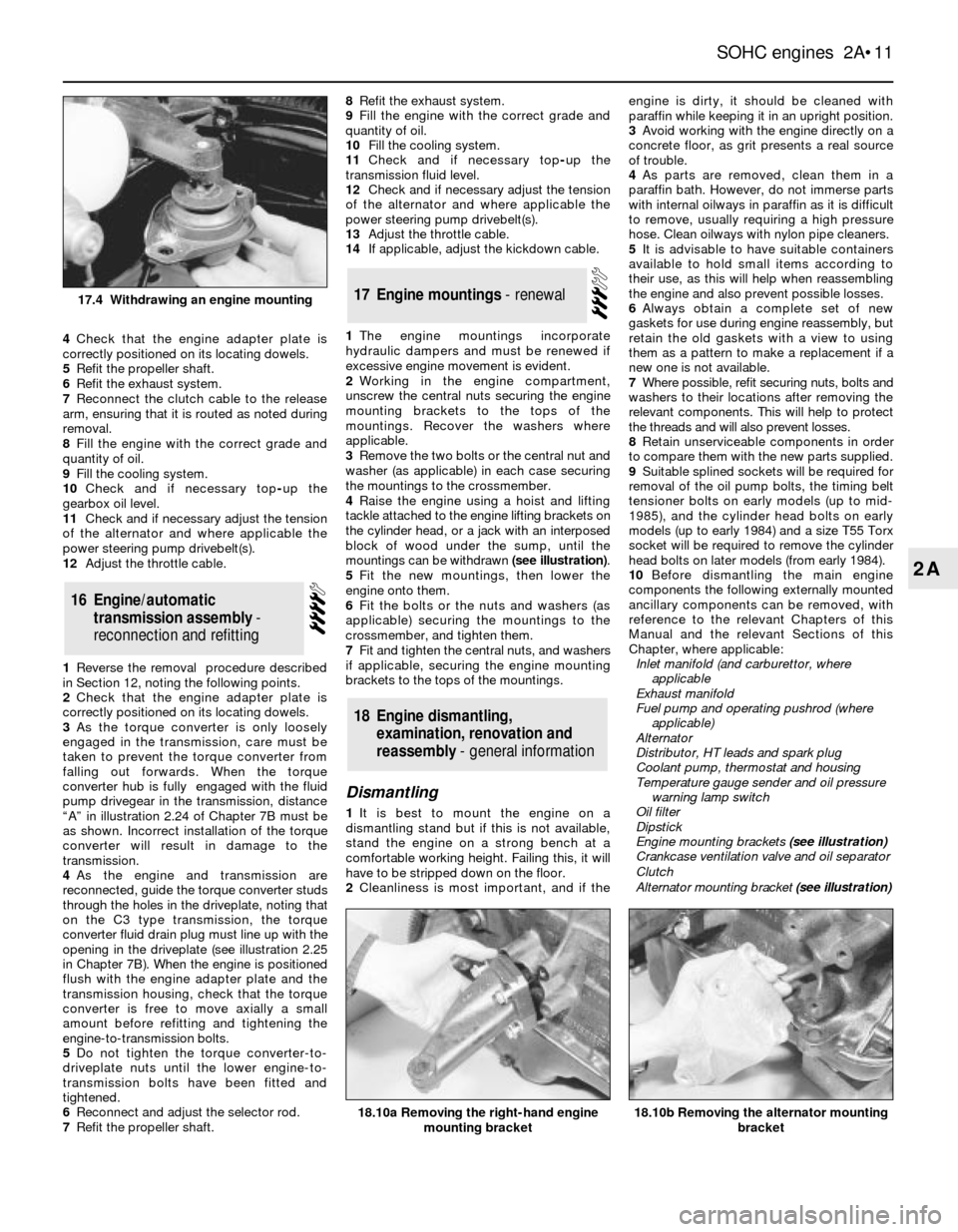
4Check that the engine adapter plate is
correctly positioned on its locating dowels.
5Refit the propeller shaft.
6Refit the exhaust system.
7Reconnect the clutch cable to the release
arm, ensuring that it is routed as noted during
removal.
8Fill the engine with the correct grade and
quantity of oil.
9Fill the cooling system.
10Check and if necessary top-up the
gearbox oil level.
11Check and if necessary adjust the tension
of the alternator and where applicable the
power steering pump drivebelt(s).
12Adjust the throttle cable.
1Reverse the removal procedure described
in Section 12, noting the following points.
2Check that the engine adapter plate is
correctly positioned on its locating dowels.
3As the torque converter is only loosely
engaged in the transmission, care must be
taken to prevent the torque converter from
falling out forwards. When the torque
converter hub is fully engaged with the fluid
pump drivegear in the transmission, distance
ÒAÓ in illustration 2.24 of Chapter 7B must be
as shown. Incorrect installation of the torque
converter will result in damage to the
transmission.
4As the engine and transmission are
reconnected, guide the torque converter studs
through the holes in the driveplate, noting that
on the C3 type transmission, the torque
converter fluid drain plug must line up with the
opening in the driveplate (see illustration 2.25
in Chapter 7B). When the engine is positioned
flush with the engine adapter plate and the
transmission housing, check that the torque
converter is free to move axially a small
amount before refitting and tightening the
engine-to-transmission bolts.
5Do not tighten the torque converter-to-
driveplate nuts until the lower engine-to-
transmission bolts have been fitted and
tightened.
6Reconnect and adjust the selector rod.
7Refit the propeller shaft.8Refit the exhaust system.
9Fill the engine with the correct grade and
quantity of oil.
10Fill the cooling system.
11Check and if necessary top-up the
transmission fluid level.
12Check and if necessary adjust the tension
of the alternator and where applicable the
power steering pump drivebelt(s).
13Adjust the throttle cable.
14If applicable, adjust the kickdown cable.
1The engine mountings incorporate
hydraulic dampers and must be renewed if
excessive engine movement is evident.
2Working in the engine compartment,
unscrew the central nuts securing the engine
mounting brackets to the tops of the
mountings. Recover the washers where
applicable.
3Remove the two bolts or the central nut and
washer (as applicable) in each case securing
the mountings to the crossmember.
4Raise the engine using a hoist and lifting
tackle attached to the engine lifting brackets on
the cylinder head, or a jack with an interposed
block of wood under the sump, until the
mountings can be withdrawn (see illustration).
5Fit the new mountings, then lower the
engine onto them.
6Fit the bolts or the nuts and washers (as
applicable) securing the mountings to the
crossmember, and tighten them.
7Fit and tighten the central nuts, and washers
if applicable, securing the engine mounting
brackets to the tops of the mountings.
Dismantling
1It is best to mount the engine on a
dismantling stand but if this is not available,
stand the engine on a strong bench at a
comfortable working height. Failing this, it will
have to be stripped down on the floor.
2Cleanliness is most important, and if theengine is dirty, it should be cleaned with
paraffin while keeping it in an upright position.
3Avoid working with the engine directly on a
concrete floor, as grit presents a real source
of trouble.
4As parts are removed, clean them in a
paraffin bath. However, do not immerse parts
with internal oilways in paraffin as it is difficult
to remove, usually requiring a high pressure
hose. Clean oilways with nylon pipe cleaners.
5It is advisable to have suitable containers
available to hold small items according to
their use, as this will help when reassembling
the engine and also prevent possible losses.
6Always obtain a complete set of new
gaskets for use during engine reassembly, but
retain the old gaskets with a view to using
them as a pattern to make a replacement if a
new one is not available.
7Where possible, refit securing nuts, bolts and
washers to their locations after removing the
relevant components. This will help to protect
the threads and will also prevent losses.
8Retain unserviceable components in order
to compare them with the new parts supplied.
9Suitable splined sockets will be required for
removal of the oil pump bolts, the timing belt
tensioner bolts on early models (up to mid-
1985), and the cylinder head bolts on early
models (up to early 1984) and a size T55 Torx
socket will be required to remove the cylinder
head bolts on later models (from early 1984).
10Before dismantling the main engine
components the following externally mounted
ancillary components can be removed, with
reference to the relevant Chapters of this
Manual and the relevant Sections of this
Chapter, where applicable:
Inlet manifold (and carburettor, where
applicable
Exhaust manifold
Fuel pump and operating pushrod (where
applicable)
Alternator
Distributor, HT leads and spark plug
Coolant pump, thermostat and housing
Temperature gauge sender and oil pressure
warning lamp switch
Oil filter
Dipstick
Engine mounting brackets (see illustration)
Crankcase ventilation valve and oil separator
Clutch
Alternator mounting bracket (see illustration)
18Engine dismantling,
examination, renovation and
reassembly - general information
17Engine mountings - renewal
16Engine/automatic
transmission assembly -
reconnection and refitting
SOHC engines 2A¥11
2A
18.10b Removing the alternator mounting
bracket18.10a Removing the right-hand engine
mounting bracket
17.4 Withdrawing an engine mounting
Page 12 of 24
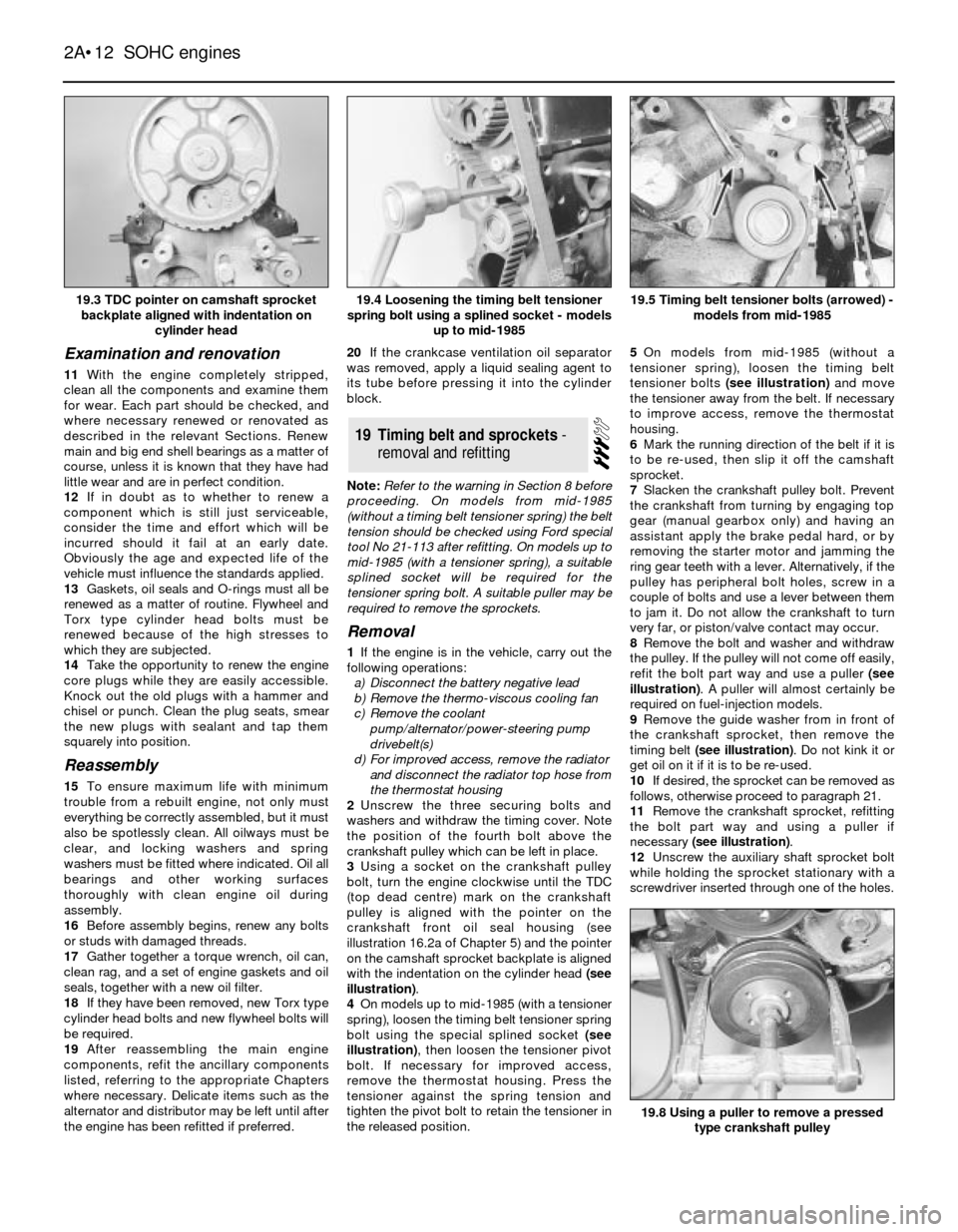
Examination and renovation
11With the engine completely stripped,
clean all the components and examine them
for wear. Each part should be checked, and
where necessary renewed or renovated as
described in the relevant Sections. Renew
main and big end shell bearings as a matter of
course, unless it is known that they have had
little wear and are in perfect condition.
12If in doubt as to whether to renew a
component which is still just serviceable,
consider the time and effort which will be
incurred should it fail at an early date.
Obviously the age and expected life of the
vehicle must influence the standards applied.
13Gaskets, oil seals and O-rings must all be
renewed as a matter of routine. Flywheel and
Torx type cylinder head bolts must be
renewed because of the high stresses to
which they are subjected.
14Take the opportunity to renew the engine
core plugs while they are easily accessible.
Knock out the old plugs with a hammer and
chisel or punch. Clean the plug seats, smear
the new plugs with sealant and tap them
squarely into position.
Reassembly
15To ensure maximum life with minimum
trouble from a rebuilt engine, not only must
everything be correctly assembled, but it must
also be spotlessly clean. All oilways must be
clear, and locking washers and spring
washers must be fitted where indicated. Oil all
bearings and other working surfaces
thoroughly with clean engine oil during
assembly.
16Before assembly begins, renew any bolts
or studs with damaged threads.
17Gather together a torque wrench, oil can,
clean rag, and a set of engine gaskets and oil
seals, together with a new oil filter.
18If they have been removed, new Torx type
cylinder head bolts and new flywheel bolts will
be required.
19After reassembling the main engine
components, refit the ancillary components
listed, referring to the appropriate Chapters
where necessary. Delicate items such as the
alternator and distributor may be left until after
the engine has been refitted if preferred.20If the crankcase ventilation oil separator
was removed, apply a liquid sealing agent to
its tube before pressing it into the cylinder
block.
Note: Refer to the warning in Section 8 before
proceeding. On models from mid-1985
(without a timing belt tensioner spring) the belt
tension should be checked using Ford special
tool No 21-113 after refitting. On models up to
mid-1985 (with a tensioner spring), a suitable
splined socket will be required for the
tensioner spring bolt. A suitable puller may be
required to remove the sprockets.
Removal
1If the engine is in the vehicle, carry out the
following operations:
a)Disconnect the battery negative lead
b)Remove the thermo-viscous cooling fan
c)Remove the coolant
pump/alternator/power-steering pump
drivebelt(s)
d)For improved access, remove the radiator
and disconnect the radiator top hose from
the thermostat housing
2Unscrew the three securing bolts and
washers and withdraw the timing cover. Note
the position of the fourth bolt above the
crankshaft pulley which can be left in place.
3Using a socket on the crankshaft pulley
bolt, turn the engine clockwise until the TDC
(top dead centre) mark on the crankshaft
pulley is aligned with the pointer on the
crankshaft front oil seal housing (see
illustration 16.2a of Chapter 5) and the pointer
on the camshaft sprocket backplate is aligned
with the indentation on the cylinder head (see
illustration).
4On models up to mid-1985 (with a tensioner
spring), loosen the timing belt tensioner spring
bolt using the special splined socket (see
illustration), then loosen the tensioner pivot
bolt. If necessary for improved access,
remove the thermostat housing. Press the
tensioner against the spring tension and
tighten the pivot bolt to retain the tensioner in
the released position.5On models from mid-1985 (without a
tensioner spring), loosen the timing belt
tensioner bolts (see illustration)and move
the tensioner away from the belt. If necessary
to improve access, remove the thermostat
housing.
6Mark the running direction of the belt if it is
to be re-used, then slip it off the camshaft
sprocket.
7Slacken the crankshaft pulley bolt. Prevent
the crankshaft from turning by engaging top
gear (manual gearbox only) and having an
assistant apply the brake pedal hard, or by
removing the starter motor and jamming the
ring gear teeth with a lever. Alternatively, if the
pulley has peripheral bolt holes, screw in a
couple of bolts and use a lever between them
to jam it. Do not allow the crankshaft to turn
very far, or piston/valve contact may occur.
8Remove the bolt and washer and withdraw
the pulley. If the pulley will not come off easily,
refit the bolt part way and use a puller (see
illustration). A puller will almost certainly be
required on fuel-injection models.
9Remove the guide washer from in front of
the crankshaft sprocket, then remove the
timing belt (see illustration). Do not kink it or
get oil on it if it is to be re-used.
10If desired, the sprocket can be removed as
follows, otherwise proceed to paragraph 21.
11Remove the crankshaft sprocket, refitting
the bolt part way and using a puller if
necessary (see illustration).
12Unscrew the auxiliary shaft sprocket bolt
while holding the sprocket stationary with a
screwdriver inserted through one of the holes.
19Timing belt and sprockets -
removal and refitting
2A¥12SOHC engines
19.3 TDC pointer on camshaft sprocket
backplate aligned with indentation on
cylinder head19.5 Timing belt tensioner bolts (arrowed) -
models from mid-1985
19.8 Using a puller to remove a pressed
type crankshaft pulley
19.4 Loosening the timing belt tensioner
spring bolt using a splined socket - models
up to mid-1985
Page 20 of 24
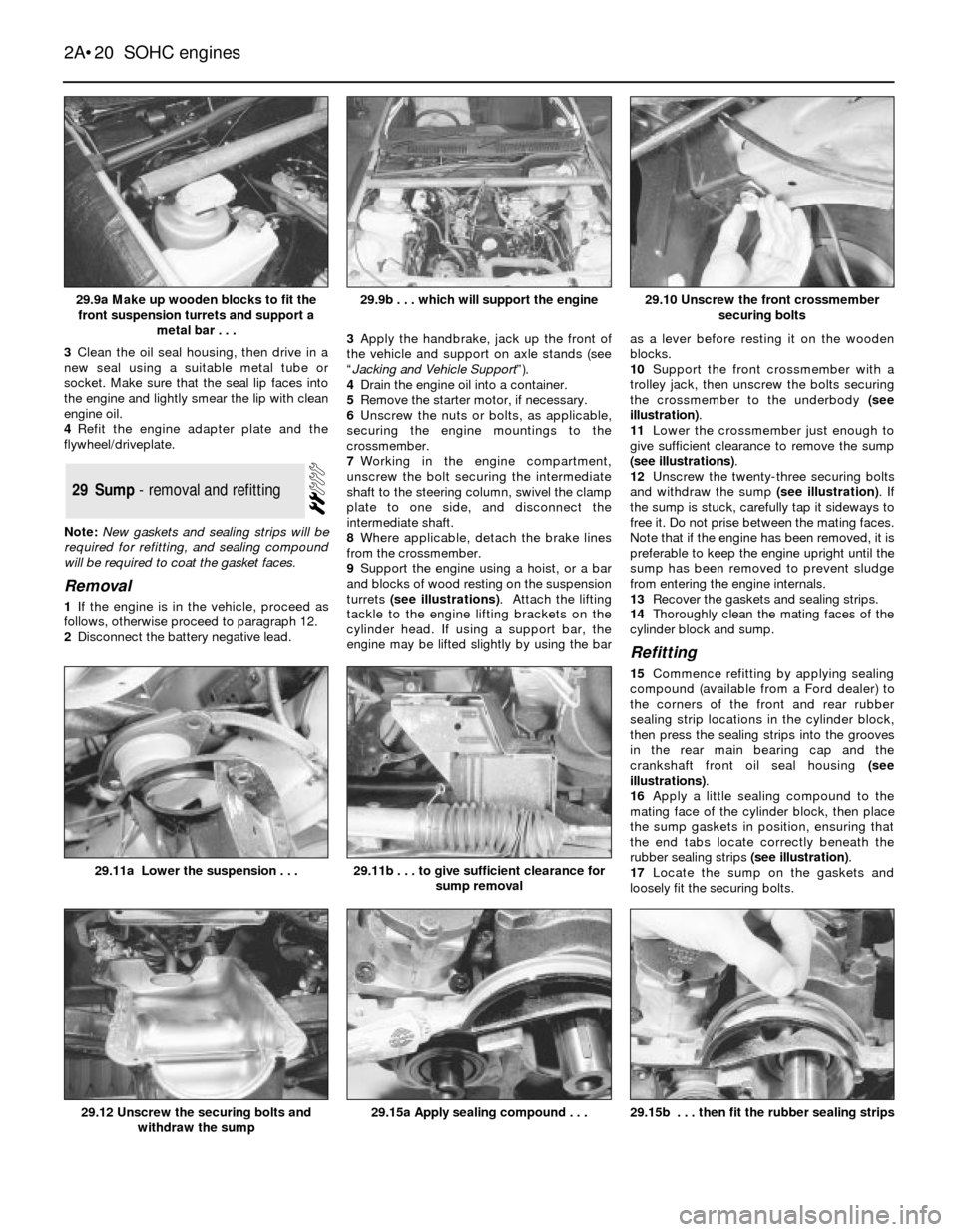
3Clean the oil seal housing, then drive in a
new seal using a suitable metal tube or
socket. Make sure that the seal lip faces into
the engine and lightly smear the lip with clean
engine oil.
4Refit the engine adapter plate and the
flywheel/driveplate.
Note: New gaskets and sealing strips will be
required for refitting, and sealing compound
will be required to coat the gasket faces.
Removal
1If the engine is in the vehicle, proceed as
follows, otherwise proceed to paragraph 12.
2Disconnect the battery negative lead.3Apply the handbrake, jack up the front of
the vehicle and support on axle stands (see
ÒJacking and Vehicle SupportÓ).
4Drain the engine oil into a container.
5Remove the starter motor, if necessary.
6Unscrew the nuts or bolts, as applicable,
securing the engine mountings to the
crossmember.
7Working in the engine compartment,
unscrew the bolt securing the intermediate
shaft to the steering column, swivel the clamp
plate to one side, and disconnect the
intermediate shaft.
8Where applicable, detach the brake lines
from the crossmember.
9Support the engine using a hoist, or a bar
and blocks of wood resting on the suspension
turrets (see illustrations). Attach the lifting
tackle to the engine lifting brackets on the
cylinder head. If using a support bar, the
engine may be lifted slightly by using the baras a lever before resting it on the wooden
blocks.
10Support the front crossmember with a
trolley jack, then unscrew the bolts securing
the crossmember to the underbody (see
illustration).
11Lower the crossmember just enough to
give sufficient clearance to remove the sump
(see illustrations).
12Unscrew the twenty-three securing bolts
and withdraw the sump (see illustration). If
the sump is stuck, carefully tap it sideways to
free it. Do not prise between the mating faces.
Note that if the engine has been removed, it is
preferable to keep the engine upright until the
sump has been removed to prevent sludge
from entering the engine internals.
13Recover the gaskets and sealing strips.
14Thoroughly clean the mating faces of the
cylinder block and sump.
Refitting
15Commence refitting by applying sealing
compound (available from a Ford dealer) to
the corners of the front and rear rubber
sealing strip locations in the cylinder block,
then press the sealing strips into the grooves
in the rear main bearing cap and the
crankshaft front oil seal housing (see
illustrations).
16Apply a little sealing compound to the
mating face of the cylinder block, then place
the sump gaskets in position, ensuring that
the end tabs locate correctly beneath the
rubber sealing strips (see illustration).
17Locate the sump on the gaskets and
loosely fit the securing bolts.
29Sump - removal and refitting
2A¥20SOHC engines
29.9a Make up wooden blocks to fit the
front suspension turrets and support a
metal bar . . .29.10 Unscrew the front crossmember
securing bolts
29.15b . . . then fit the rubber sealing strips29.15a Apply sealing compound . . .29.12 Unscrew the securing bolts and
withdraw the sump
29.11b . . . to give sufficient clearance for
sump removal29.11a Lower the suspension . . .
29.9b . . . which will support the engine
Page 21 of 24
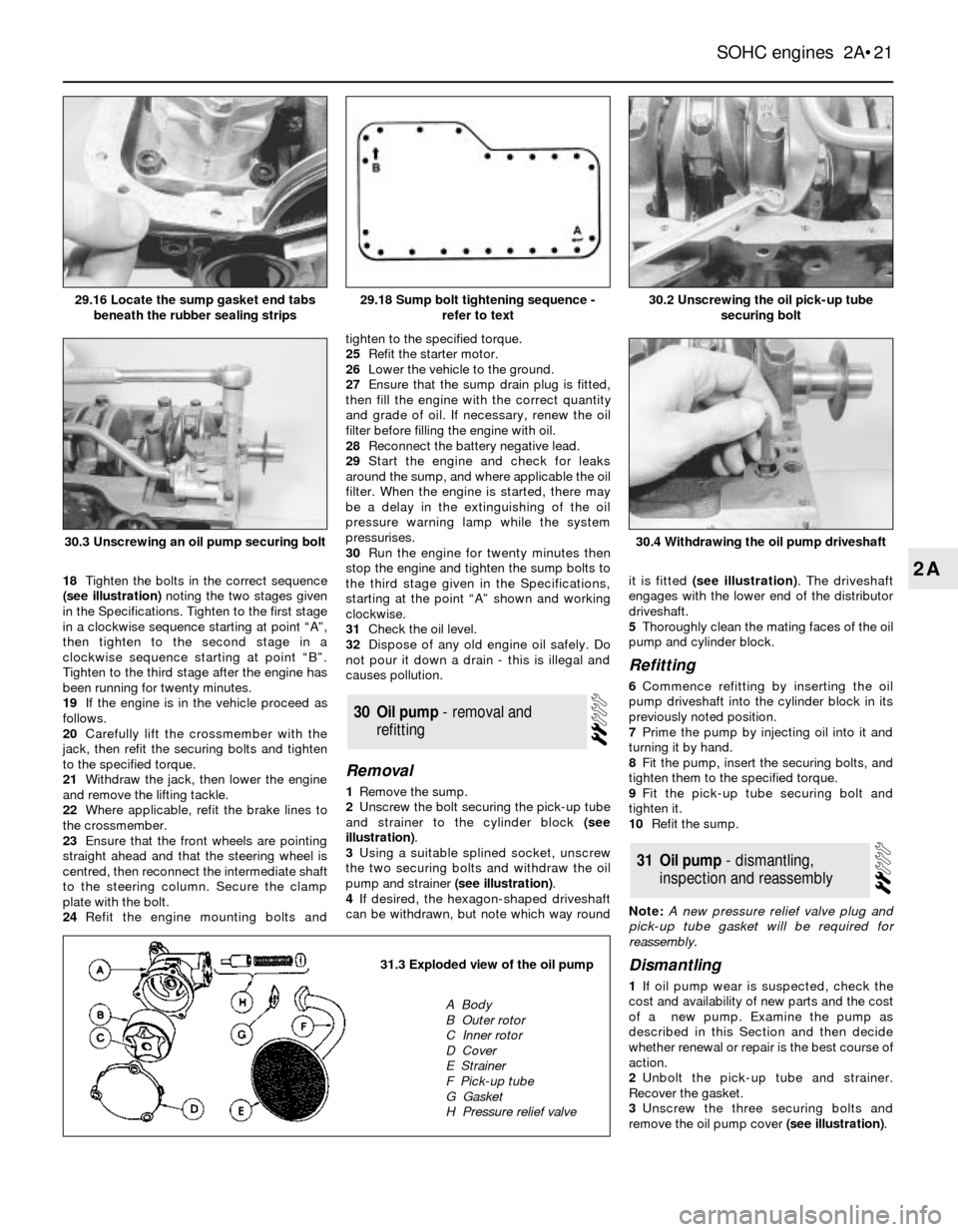
18Tighten the bolts in the correct sequence
(see illustration)noting the two stages given
in the Specifications. Tighten to the first stage
in a clockwise sequence starting at point ÒAÓ,
then tighten to the second stage in a
clockwise sequence starting at point ÒBÓ.
Tighten to the third stage after the engine has
been running for twenty minutes.
19If the engine is in the vehicle proceed as
follows.
20Carefully lift the crossmember with the
jack, then refit the securing bolts and tighten
to the specified torque.
21Withdraw the jack, then lower the engine
and remove the lifting tackle.
22Where applicable, refit the brake lines to
the crossmember.
23Ensure that the front wheels are pointing
straight ahead and that the steering wheel is
centred, then reconnect the intermediate shaft
to the steering column. Secure the clamp
plate with the bolt.
24Refit the engine mounting bolts andtighten to the specified torque.
25Refit the starter motor.
26Lower the vehicle to the ground.
27Ensure that the sump drain plug is fitted,
then fill the engine with the correct quantity
and grade of oil. If necessary, renew the oil
filter before filling the engine with oil.
28Reconnect the battery negative lead.
29Start the engine and check for leaks
around the sump, and where applicable the oil
filter. When the engine is started, there may
be a delay in the extinguishing of the oil
pressure warning lamp while the system
pressurises.
30Run the engine for twenty minutes then
stop the engine and tighten the sump bolts to
the third stage given in the Specifications,
starting at the point ÒAÓ shown and working
clockwise.
31Check the oil level.
32Dispose of any old engine oil safely. Do
not pour it down a drain - this is illegal and
causes pollution.
Removal
1Remove the sump.
2Unscrew the bolt securing the pick-up tube
and strainer to the cylinder block (see
illustration).
3Using a suitable splined socket, unscrew
the two securing bolts and withdraw the oil
pump and strainer (see illustration).
4If desired, the hexagon-shaped driveshaft
can be withdrawn, but note which way roundit is fitted (see illustration). The driveshaft
engages with the lower end of the distributor
driveshaft.
5Thoroughly clean the mating faces of the oil
pump and cylinder block.
Refitting
6Commence refitting by inserting the oil
pump driveshaft into the cylinder block in its
previously noted position.
7Prime the pump by injecting oil into it and
turning it by hand.
8Fit the pump, insert the securing bolts, and
tighten them to the specified torque.
9Fit the pick-up tube securing bolt and
tighten it.
10Refit the sump.
Note: A new pressure relief valve plug and
pick-up tube gasket will be required for
reassembly.
Dismantling
1If oil pump wear is suspected, check the
cost and availability of new parts and the cost
of a new pump. Examine the pump as
described in this Section and then decide
whether renewal or repair is the best course of
action.
2Unbolt the pick-up tube and strainer.
Recover the gasket.
3Unscrew the three securing bolts and
remove the oil pump cover (see illustration).
31Oil pump - dismantling,
inspection and reassembly
30Oil pump - removal and
refitting
SOHC engines 2A¥21
2A
30.2 Unscrewing the oil pick-up tube
securing bolt
30.4 Withdrawing the oil pump driveshaft30.3 Unscrewing an oil pump securing bolt
29.18 Sump bolt tightening sequence -
refer to text29.16 Locate the sump gasket end tabs
beneath the rubber sealing strips
31.3 Exploded view of the oil pump
A Body
B Outer rotor
C Inner rotor
D Cover
E Strainer
F Pick-up tube
G Gasket
H Pressure relief valve
Page 24 of 24
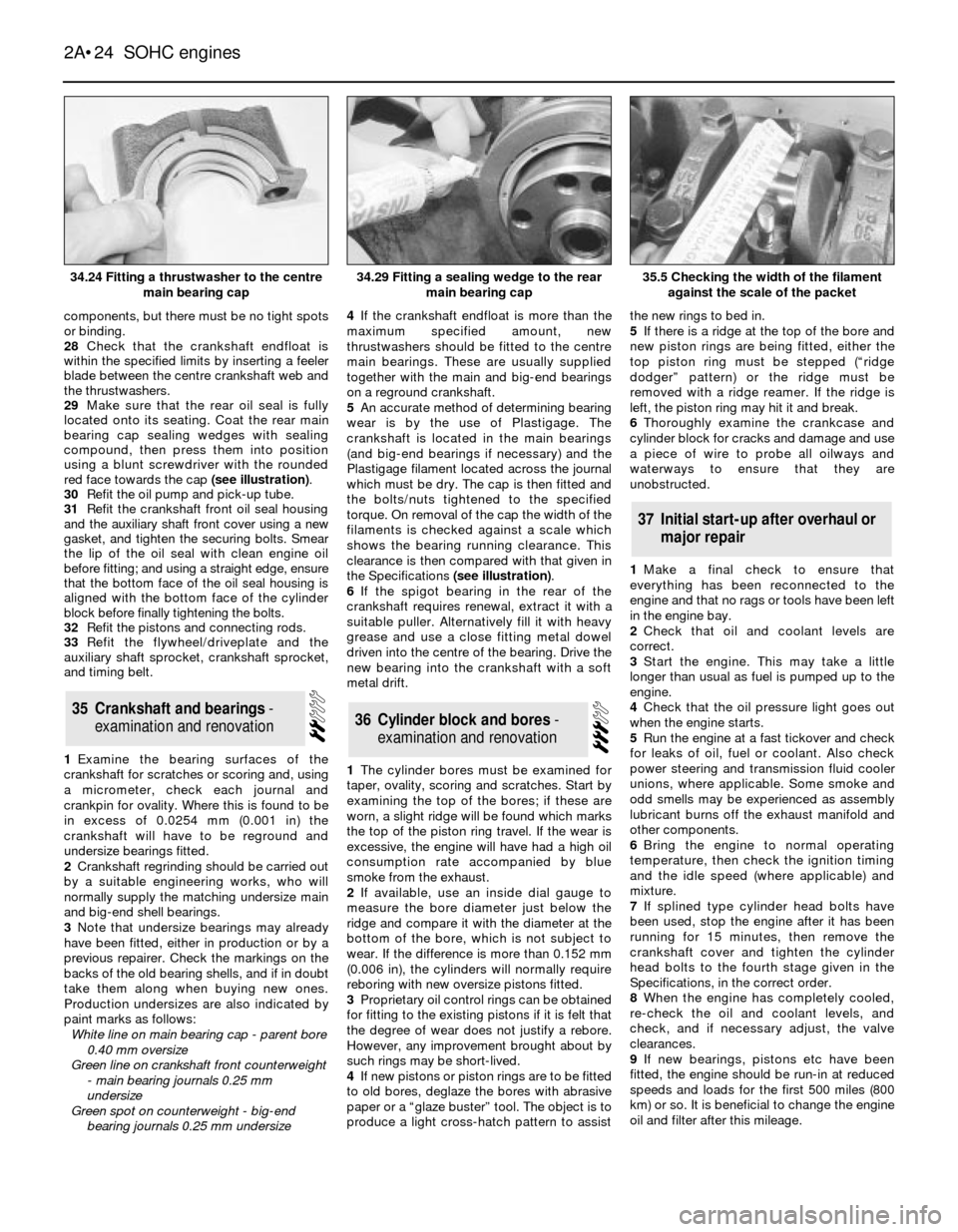
components, but there must be no tight spots
or binding.
28Check that the crankshaft endfloat is
within the specified limits by inserting a feeler
blade between the centre crankshaft web and
the thrustwashers.
29Make sure that the rear oil seal is fully
located onto its seating. Coat the rear main
bearing cap sealing wedges with sealing
compound, then press them into position
using a blunt screwdriver with the rounded
red face towards the cap (see illustration).
30Refit the oil pump and pick-up tube.
31Refit the crankshaft front oil seal housing
and the auxiliary shaft front cover using a new
gasket, and tighten the securing bolts. Smear
the lip of the oil seal with clean engine oil
before fitting; and using a straight edge, ensure
that the bottom face of the oil seal housing is
aligned with the bottom face of the cylinder
block before finally tightening the bolts.
32Refit the pistons and connecting rods.
33Refit the flywheel/driveplate and the
auxiliary shaft sprocket, crankshaft sprocket,
and timing belt.
1Examine the bearing surfaces of the
crankshaft for scratches or scoring and, using
a micrometer, check each journal and
crankpin for ovality. Where this is found to be
in excess of 0.0254 mm (0.001 in) the
crankshaft will have to be reground and
undersize bearings fitted.
2Crankshaft regrinding should be carried out
by a suitable engineering works, who will
normally supply the matching undersize main
and big-end shell bearings.
3Note that undersize bearings may already
have been fitted, either in production or by a
previous repairer. Check the markings on the
backs of the old bearing shells, and if in doubt
take them along when buying new ones.
Production undersizes are also indicated by
paint marks as follows:
White line on main bearing cap - parent bore
0.40 mm oversize
Green line on crankshaft front counterweight
- main bearing journals 0.25 mm
undersize
Green spot on counterweight - big-end
bearing journals 0.25 mm undersize4If the crankshaft endfloat is more than the
maximum specified amount, new
thrustwashers should be fitted to the centre
main bearings. These are usually supplied
together with the main and big-end bearings
on a reground crankshaft.
5An accurate method of determining bearing
wear is by the use of Plastigage. The
crankshaft is located in the main bearings
(and big-end bearings if necessary) and the
Plastigage filament located across the journal
which must be dry. The cap is then fitted and
the bolts/nuts tightened to the specified
torque. On removal of the cap the width of the
filaments is checked against a scale which
shows the bearing running clearance. This
clearance is then compared with that given in
the Specifications (see illustration).
6If the spigot bearing in the rear of the
crankshaft requires renewal, extract it with a
suitable puller. Alternatively fill it with heavy
grease and use a close fitting metal dowel
driven into the centre of the bearing. Drive the
new bearing into the crankshaft with a soft
metal drift.
1The cylinder bores must be examined for
taper, ovality, scoring and scratches. Start by
examining the top of the bores; if these are
worn, a slight ridge will be found which marks
the top of the piston ring travel. If the wear is
excessive, the engine will have had a high oil
consumption rate accompanied by blue
smoke from the exhaust.
2If available, use an inside dial gauge to
measure the bore diameter just below the
ridge and compare it with the diameter at the
bottom of the bore, which is not subject to
wear. If the difference is more than 0.152 mm
(0.006 in), the cylinders will normally require
reboring with new oversize pistons fitted.
3Proprietary oil control rings can be obtained
for fitting to the existing pistons if it is felt that
the degree of wear does not justify a rebore.
However, any improvement brought about by
such rings may be short-lived.
4If new pistons or piston rings are to be fitted
to old bores, deglaze the bores with abrasive
paper or a Òglaze busterÓ tool. The object is to
produce a light cross-hatch pattern to assistthe new rings to bed in.
5If there is a ridge at the top of the bore and
new piston rings are being fitted, either the
top piston ring must be stepped (Òridge
dodgerÓ pattern) or the ridge must be
removed with a ridge reamer. If the ridge is
left, the piston ring may hit it and break.
6Thoroughly examine the crankcase and
cylinder block for cracks and damage and use
a piece of wire to probe all oilways and
waterways to ensurethatthey are
unobstructed.
1Make a final check to ensure that
everything has been reconnected to the
engine and that no rags or tools have been left
in the engine bay.
2Check that oil and coolant levels are
correct.
3Start the engine. This may take a little
longer than usual as fuel is pumped up to the
engine.
4Check that the oil pressure light goes out
when the engine starts.
5Run the engine at a fast tickover and check
for leaks of oil, fuel or coolant. Also check
power steering and transmission fluid cooler
unions, where applicable. Some smoke and
odd smells may be experienced as assembly
lubricant burns off the exhaust manifold and
other components.
6Bring the engine to normal operating
temperature, then check the ignition timing
and the idle speed (where applicable) and
mixture.
7If splined type cylinder head bolts have
been used, stop the engine after it has been
running for 15 minutes, then remove the
crankshaft cover and tighten the cylinder
head bolts to the fourth stage given in the
Specifications, in the correct order.
8When the engine has completely cooled,
re-check the oil and coolant levels, and
check, and if necessary adjust, the valve
clearances.
9If new bearings, pistons etc have been
fitted, the engine should be run-in at reduced
speeds and loads for the first 500 miles (800
km) or so. It is beneficial to change the engine
oil and filter after this mileage.
37Initial start-up after overhaul or
major repair
36Cylinder block and bores -
examination and renovation35Crankshaft and bearings -
examination and renovation
2A¥24SOHC engines
34.24 Fitting a thrustwasher to the centre
main bearing cap35.5 Checking the width of the filament
against the scale of the packet34.29 Fitting a sealing wedge to the rear
main bearing cap